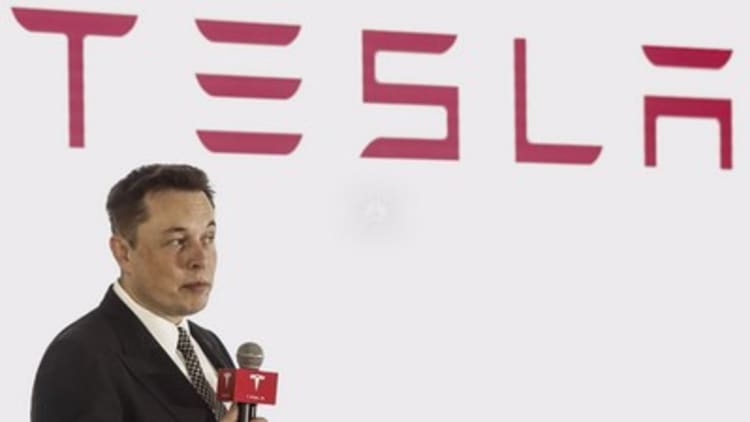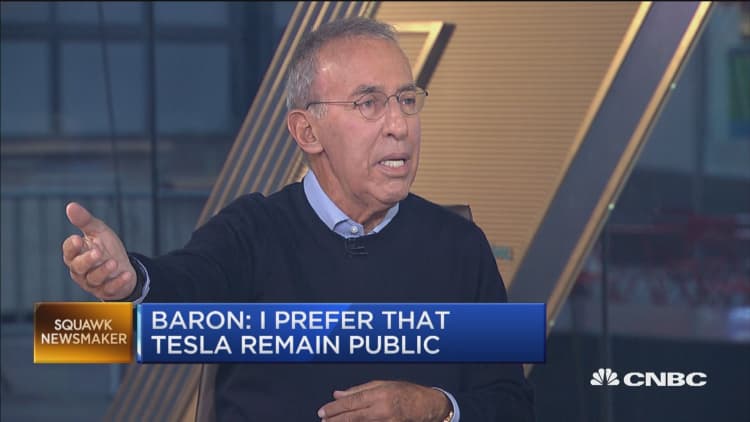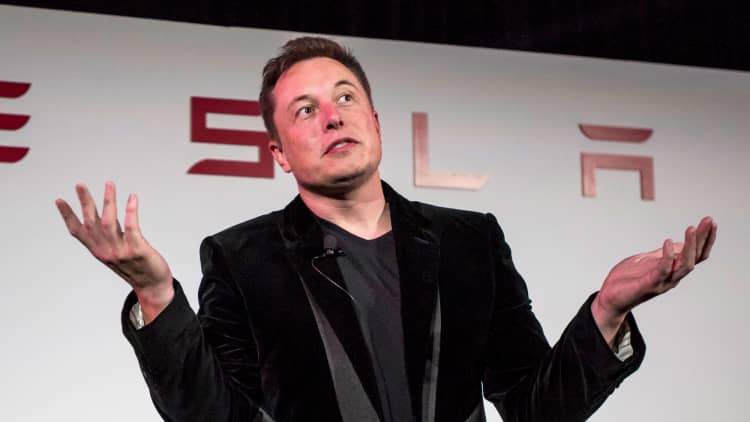
Tesla delivered 83,500 vehicles during the third quarter, beating Wall Street analysts' expectations for deliveries.
But investors are still concerned about the company's profitability and were disappointed it didn't release more detailed data on its production costs and sale prices, analysts said.
Tesla's shares fell 1.3 percent in midmorning trading despite beating Wall Street estimates for 80,500 deliveries during the quarter, according to data compiled by FactSet.
The company produced 80,142 total vehicles: 26,903 Model S and X vehicles combined, and 53,239 Model 3 sedans.
Its overall deliveries, which included 55,840 of its Model 3 sedans, were comparable to 80 percent of all of its deliveries for 2017, the company said Tuesday. Model 3 deliveries were slightly above consensus estimates of 55,600, according to FactSet. Analysts had lowered their prior estimates over the last week or so, making it easier for Tesla to beat Wall Street expectations.
"With production stabilized, delivery and outbound vehicle logistics were our main challenges" during the third quarter, the company said in a statement. "We made many improvements to these processes throughout the quarter, and plan to make further improvements in [the fourth quarter] so that we can scale successfully."

Tesla said it was able to "significantly increase" Model S and X deliveries during the quarter, "notwithstanding the headwinds we have been facing from the ongoing trade tensions between the US and China."
"The production and delivery numbers were a positive surprise for sure," said CFRA analyst Garrett Nelson. "They actually delivered into their guidance. So it seems like they have really improved operationally during the quarter, based on these results."
Investors are disappointed because Tesla didn't provide details on average sale prices or vehicle costs, he said. Investors have long been concerned about Tesla profit margins, especially the Model 3. Nelson said some of the company's good news came out ahead of the report and was already priced into the stock.
The mix of vehicles — comprised in large part of more expensive versions of the Model 3 sedans — suggests that Tesla could be turning a profit on all of its cars, Oppenheimer analyst Colin Rusch said in a research note published Tuesday. But investors were hoping to see more detailed data on its manufacturing costs and cash flow, especially since the automaker said it plans to speed up construction of its factory in Shanghai.
The company said it is accelerating construction of the Shanghai factory to try to minimize the impact of the tariffs, which have increased the tax rate on Teslas sold in China to 40 percent, compared with 15 percent for all other imported cars, the company said.
"Taking ocean transport costs and import tariffs into account, Tesla is now operating at a 55% to 60% cost disadvantage compared to the exact same car locally produced in China," the company said. "This makes for a challenging competitive environment, given that China is by far the largest market for electric vehicles."
Tesla said other disadvantages in China include a lack of cash incentives available to local automakers.
Tesla previously set a goal of producing between 50,000 and 55,000 Model 3 sedans during the quarter. Heading into the report, expectations were that the company had exceeded that goal. The Model 3 is Tesla's midsize electric sedan, and the car that is meant to turn Tesla into a mass manufacturer of electric vehicles.
CEO Elon Musk has repeatedly said he expects the company to be profitable for the third quarter. Tesla has had only two profitable quarters since it went public in 2010.
Musk recently reached a settlement with the U.S. Securities and Exchange Commission over charges of fraud resulting from comments he made about taking Tesla private. Under the terms of the settlement, Musk and Tesla will pay fines of $20 million each, and Musk will step down for at least three years as chairman.
PALO ALTO, Calif., Oct. 02, 2018 (GLOBE NEWSWIRE) -- In Q3, we produced 80,142 vehicles, 50% more than our prior all-time high in Q2, including:
- 53,239 Model 3 vehicles, which was in line with our guidance and almost double the volume of Q2. During Q3, we transitioned Model 3 production from entirely rear wheel drive at the beginning of the quarter to almost entirely dual motor during the last few weeks of the quarter. This added significant complexity, but we successfully executed this transition and ultimately produced more dual motor than rear wheel drive cars in Q3. In the last week of the quarter, we produced over 5,300 Model 3 vehicles, almost all of which were dual motor, meaning that we achieved a production rate of more than 10,000 drive units per week.
- 26,903 Model S and X vehicles, which was slightly higher than Q2 and in line with our full-year guidance.
Q3 deliveries totaled 83,500 vehicles: 55,840 Model 3, 14,470 Model S, and 13,190 Model X. To put this in perspective, in just Q3, we delivered more than 80% of the vehicles that we delivered in all of 2017, and we delivered about twice as many Model 3s as we did in all previous quarters combined.
Our Q3 Model 3 deliveries were limited to higher-priced variants, cash/loan transactions, and North American customers only. There remain significant opportunities to grow the addressable market for Model 3 by introducing leasing, standard battery and other lower-priced variants of the car, and by starting international deliveries.
Demand for Model S and X remains high. In Q3, we were able to significantly increase Model S and X deliveries notwithstanding the headwinds we have been facing from the ongoing trade tensions between the US and China. Those trade tensions have resulted in an import tariff rate of 40% on Tesla vehicles versus 15% for other imported cars in China.
In addition, Tesla continues to lack access to cash incentives available to locally produced electric vehicles in China that are typically around 15% of MSRP or more. Taking ocean transport costs and import tariffs into account, Tesla is now operating at a 55% to 60% cost disadvantage compared to the exact same car locally produced in China. This makes for a challenging competitive environment, given that China is by far the largest market for electric vehicles. To address this issue, we are accelerating construction of our Shanghai factory, which we expect to be a capital efficient and rapid buildout, using many lessons learned from the Model 3 ramp in North America.
With production stabilized, delivery and outbound vehicle logistics were our main challenges during Q3. We made many improvements to these processes throughout the quarter, and plan to make further improvements in Q4 so that we can scale successfully. As part of this effort, we plan to continue to expand direct deliveries to customers at their home or office, a service we launched in Q3 to improve customer convenience.
8,048 Model 3 vehicles and 3,776 Model S and X vehicles were in transit to customers at the end of Q3, and will be delivered in early Q4. Our overall target of 100,000 Model S and X deliveries in 2018 remains unchanged.
Our net income and cash flow results will be announced along with the rest of our financial performance when we announce Q3 earnings.
We want to thank the entire Tesla team for executing so well during this challenging ramp up in deliveries. We also want to thank all of our customers who volunteered to help us with deliveries, and our new customers who are showing their faith in Tesla by purchasing our products in such large numbers. It was beyond inspiring to see the contributions made by the whole Tesla community.
***************
Our delivery count should be viewed as slightly conservative, as we only count a car as delivered if it is transferred to the customer and all paperwork is correct. Final numbers could vary by up to 0.5%. Tesla vehicle deliveries represent only one measure of the company's financial performance and should not be relied on as an indicator of quarterly financial results, which depend on a variety of factors, including the cost of sales, foreign exchange movements and mix of directly leased vehicles.
Forward-Looking Statements
Certain statements herein, including statements regarding future production and delivery of Model S and Model X, expanding direct vehicle deliveries, growing the addressable market for Model 3, and accelerating the buildout of the Shanghai factory in a capital efficient and rapid manner, are "forward-looking statements" that are subject to risks and uncertainties. These forward-looking statements are based on management's current expectations. Various important factors could cause actual results to differ materially, including the risks identified in our SEC filings. Tesla disclaims any obligation to update this information.
Correction: This story was revised to correct that Tesla's third-quarter deliveries were more than 80 percent of the vehicles it delivered in all of 2017. It also corrected the total production number of all Teslas, including its Model 3. Earlier versions also mischaracterized data on deliveries. Model 3 deliveries exceeded analysts' expectations.



